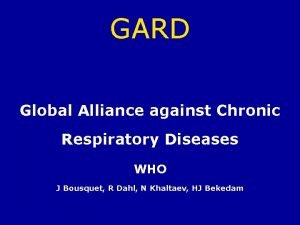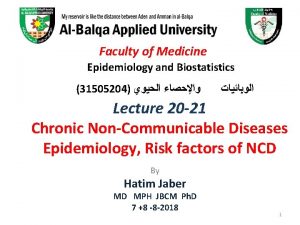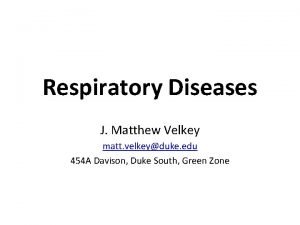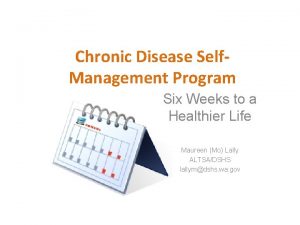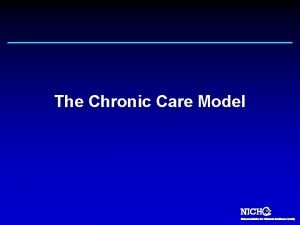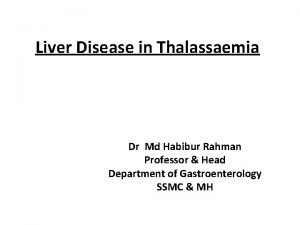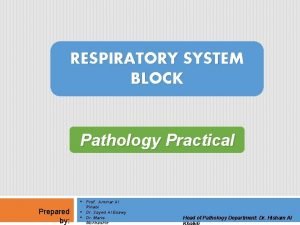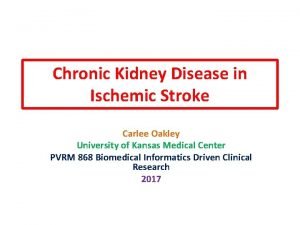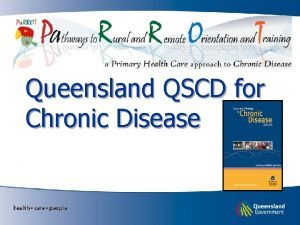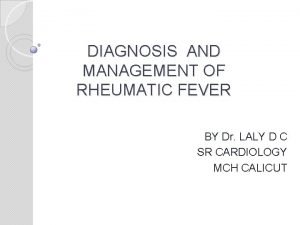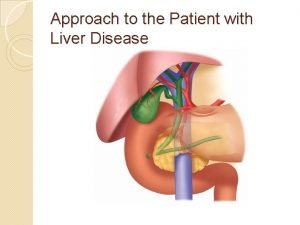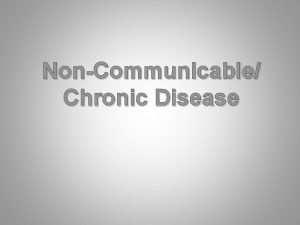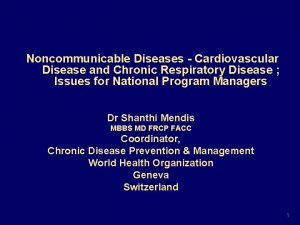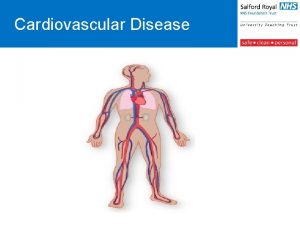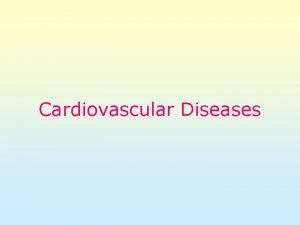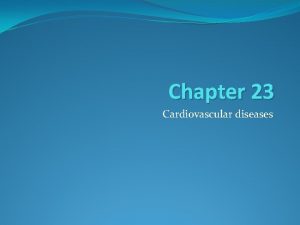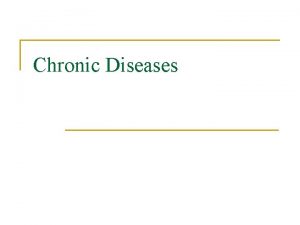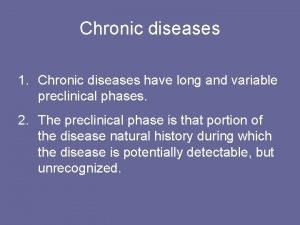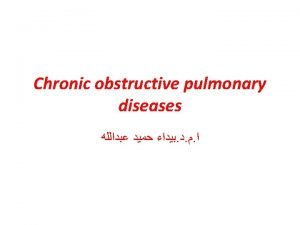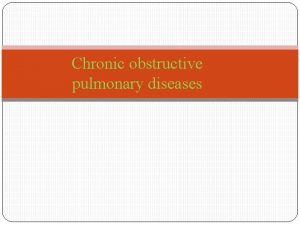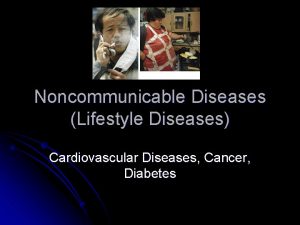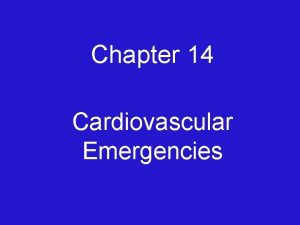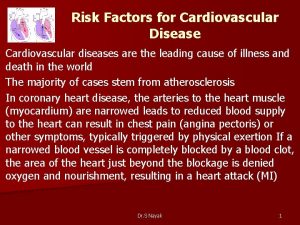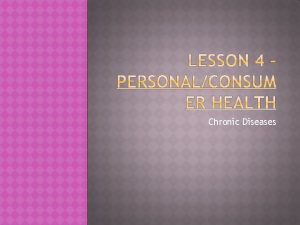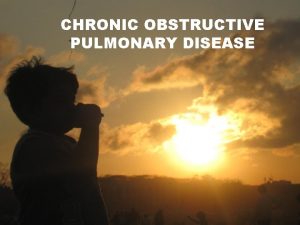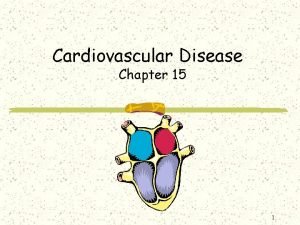Chronic Diseases Cardiovascular Disease Disease that affects the




















- Slides: 20

Chronic Diseases

Cardiovascular Disease § Disease that affects the heart or blood vessels § Two types – hypertension and atherosclerosis § Behavioral factors – smoking, poor diet, lack of physical activity, alcohol abuse, obesity, poor stress management § Environmental factors – stressful workplace


Hypertension § High blood pressure. § It can damage blood vessels and heart over a long period of time. § It is called the “silent killer”. § It is most common in people over the age of 35. § Prevent it by eating healthy, exercising regularly, and managing your weight.


Atherosclerosis § An accumulation of plaque on artery walls. § Typically caused by unhealthy food choices high in saturated fats and cholesterol. § As the plaque builds, it hardens on the walls of the arteries. § It can lead to strokes and heart attacks.


Cancer § Uncontrollable growth of abnormal cells § Tumor – abnormal mass of tissue that has no natural role in the body. They are not always associated with cancer. There are two types – benign and malignant.


Skin Cancer § Also called melanoma. § Can be detected in physical exam and removed by a biopsy. § Behavioral factors – exposure to the sun or radiation, failure to use sunscreen/clothing/shade, use of tanning beds. § Environmental factors – depletion of ozone layer, lack of shade, time of day, occupation



Lung Cancer § Can also be classified as carcinoma (aggressive). § Typically no immediate symptoms. § May have severe cough, wheezing, coughing up blood, and hoarseness. § It is detected in a chest x-ray. § Behavioral factors – smoking, general air pollution § Environmental factors – exposure to radon, asbestos


Osteoporosis § Condition in which there is a progressive loss of bone tissue. § Healthful behaviors during teen years can reduce your risk of developing osteoporosis later in life. § Can be detected by a bone scan. § Behavioral factors – lack of physical activity, lack of calcium and vitamin D in diet. § Environmental factors – none identified


Bronchitis § An inflammation of the bronchi caused by infection or exposure to irritants such as tobacco smoke or air pollution. § Also causes bronchi to produce excess amounts of mucus, which block the airways causing coughing, wheezing, and shortness of breath. § Treatments include antibiotics and reducing the exposure. § Behavioral factors – smoking, choice of occupation § Environmental factors – general air pollution, asbestos in buildings, secondhand smoke


Emphysema § A disease that progressively destroys the walls of the alveoli. § Almost always caused by smoking. § Some symptoms include breathing difficulty and chronic cough. § Behavioral factors – smoking, choice of occupation § Environmental factors – general pollution, asbestos in buildings, secondhand smoke

 Cardiovascular system diseases and disorders chapter 8
Cardiovascular system diseases and disorders chapter 8 Thinking language and intelligence
Thinking language and intelligence Iceberg phenomenon definition
Iceberg phenomenon definition Global alliance against chronic respiratory diseases
Global alliance against chronic respiratory diseases Anatomy blood vessels
Anatomy blood vessels Cardiovascular disease risk factor
Cardiovascular disease risk factor Ersd
Ersd Stigmata of chronic liver disease
Stigmata of chronic liver disease Chronic granulomatous disease
Chronic granulomatous disease Chronic disease
Chronic disease Stigmata of chronic liver disease
Stigmata of chronic liver disease Wagner model of chronic disease management
Wagner model of chronic disease management Kate lorig chronic disease self-management
Kate lorig chronic disease self-management Stigmata of chronic liver disease
Stigmata of chronic liver disease Restrictive lung disease
Restrictive lung disease Nih score
Nih score Chronic disease
Chronic disease Jewish chronic disease hospital
Jewish chronic disease hospital Vijaya's echo criteria
Vijaya's echo criteria Stigmata of chronic liver disease
Stigmata of chronic liver disease Compensated cirrhosis
Compensated cirrhosis



